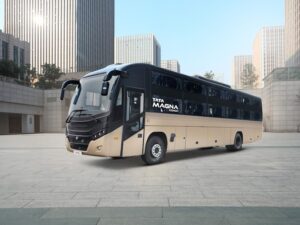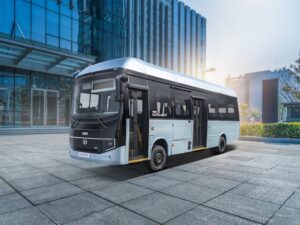In an exclusive conversation with Bus Coach India Magazine, Mr. Anand S, Vice President and Head – Commercial Passenger Vehicle Business, Tata Motors, discussed the company’s commitment to India’s e-mobility revolution. He emphasized that clean mobility is the guiding principle for Tata Motors, recognizing that the creation of a comprehensive electric mobility ecosystem is essential for wider EV adoption. The discussion, primarily focused on electric buses, covered a broad range of topics, including market outlook, safety, future innovations, and investment plans.
Q: Tata Motors has been an active participant in the Bharat Mobility Global Expo. Could you elaborate on the products displayed in the bus segment at the event?
We have showcased three key products in our bus segment at this prestigious event. The first is the Magna Intercity Coach, which features a state-of-the-art 6.7-liter Cummins engine paired with an automated manual transmission (AMT). This bus is equipped with front and rear air suspension, ensuring a smooth and comfortable ride, along with advanced safety features that set new benchmarks in passenger travel.
Our second offering is the Intercity EV 2.0, a groundbreaking electric bus designed to transform long-distance travel. Built on next-generation modular architecture, this vehicle represents a major leap forward in sustainable and efficient transportation. Passenger comfort remains a primary focus, with ergonomic seating, climate control, and a noise-free ride enhancing the overall travel experience.
Finally, we have the Tata Ultra EV9, a highly versatile electric bus designed for urban commuting. This vehicle is adaptable for multiple applications and is a testament to Tata Motors’ commitment to sustainability and technological advancement in the passenger vehicle segment.

Looking ahead to 2025, how does Tata Motors perceive the growth trajectory for the bus segment?
The bus industry is experiencing a robust growth rate of approximately 14-15%, and I am pleased to report that Tata Motors is outpacing this industry growth with a remarkable 19% increase. Several macroeconomic factors contribute to this positive trend.
Firstly, there is strong governmental support for public transportation, particularly through initiatives promoting state transport undertakings (STUs) and public-private partnerships. Secondly, rapid urbanization has led to an increased demand for school buses, staff transportation, and tourism-related travel. With more people moving between cities and exploring new destinations, the need for efficient and sustainable transportation solutions has never been greater.
Given these favorable conditions, we are optimistic that the positive momentum in the bus industry will continue well into the coming years, driving further innovation and expansion.
Q: Hydrogen fuel technology is gaining traction worldwide. Does Tata Motors plan to expand into hydrogen fuel buses?
Tata Motors has always been at the forefront of alternate fuel technologies. Our journey has evolved from diesel to compressed natural gas (CNG), and now to electric vehicles. Hydrogen fuel is the next logical step in this transition, and we are actively working on its development.
CNG has been an integral part of our portfolio for over a decade. We were the pioneers in introducing CNG buses in Delhi, and they have been successfully operating for the past 15 years across various segments, including school, staff, and city transportation.
Hydrogen fuel cell technology is still in its early stages, but we are making significant strides. We have already deployed 15 hydrogen fuel cell electric buses for Indian Oil Corporation Limited (IOCL), which have been running successfully for over a year. As this technology matures, we will continue exploring its applications and expanding our product lineup to include more hydrogen-powered buses.
Q: Could you explain the key differences between CNG and hydrogen buses?
Certainly. While both CNG and hydrogen are alternative fuels, they differ significantly in their energy sources and operational mechanisms. CNG buses run on compressed natural gas, a well-established and widely adopted fuel in India. Compared to diesel, CNG offers lower emissions and has been an important part of public transportation.
Hydrogen buses, on the other hand, utilize hydrogen fuel cells to generate electricity, which powers the vehicle. This technology results in zero emissions, with only water vapor as a byproduct. Although hydrogen fuel cell technology is still evolving, it holds great promise for the future of sustainable transportation. We remain committed to investing in research and development to further refine this technology and unlock its full potential.

Q: Safety is a major concern, especially for school buses. What measures does Tata Motors incorporate to enhance safety?
Safety is at the core of our vehicle design philosophy. Unlike private cars, buses operate in a dynamic environment, constantly interacting with passengers, pedestrians, and other vehicles. This complexity necessitates robust safety mechanisms to ensure the well-being of everyone involved.
To enhance safety, we have integrated Advanced Driver Assistance Systems (ADAS), which provide real-time alerts and assistance to drivers, significantly reducing the risk of accidents. One of the most critical features is the Driver Monitoring System, which continuously tracks the driver’s eye movements to detect signs of drowsiness or distraction, ensuring enhanced vigilance on the road.
Additionally, our Frontal Collision Warning System constantly scans the road ahead and detects potential obstacles, such as vehicles, pedestrians, or stationary objects. If an imminent collision is detected, the system promptly alerts the driver, enabling swift action to prevent an impact.
Another crucial feature is the Driver Alert System, which provides notifications regarding potential road hazards, including sharp turns, sudden traffic congestion, or unexpected obstacles. By enhancing situational awareness, this system helps drivers make informed decisions and ensures safer journeys for passengers.
Q: What are Tata Motors’ investment plans for electric and CNG buses?
Tata Motors is continuously investing in new technologies to drive innovation in clean mobility solutions. Our latest investment is reflected in the advanced electric bus showcased at this expo. Built on a modular architecture, it features regenerative braking, cutting-edge design, and advanced safety features.
We remain committed to allocating substantial capital expenditure toward next-generation vehicles, including electric and advanced CNG buses. Our ultimate goal is to lead the transition toward cleaner, more sustainable transportation solutions while ensuring the highest levels of efficiency and safety.
Q: How does Tata Motors approach research and development (R&D) in the electric and CNG segments?
Our R&D initiatives focus on enhancing efficiency, safety, and user experience across all our product lines. For CNG, we have already established a strong product portfolio, and our current focus is on incremental improvements, such as enhancing fuel efficiency, comfort, and safety.
In the EV space, we have been actively developing electric buses for the past 5-7 years. Under the first phase of the Faster Adoption and Manufacturing of Electric Vehicles (FAME) scheme, we have supplied over 3,000 electric buses, which have collectively covered 260 million kilometers across 10 metro cities.
Looking ahead, our next phase of investment will focus on new-age modular architecture that enhances operational efficiency and sustainability. The technological and design innovations showcased at Bharat Mobility Global Expo reaffirm our long-term commitment to pioneering cutting-edge mobility solutions.